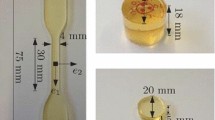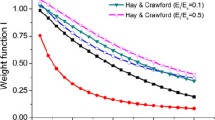Abstract
Thin polymer layers on substrates have a wide range of application in important areas. However, it is impossible to measure the mechanical properties with the traditional testing methods. Recently, nanoindentation became a new but primary testing technique of thin layers. In the present work, based on a finite element model of contact mechanics and hyperelastic materials, nanoindentation of polymer layers is simulated with the finite element code ABAQUS®. Three often used hyperelastic models, that is, the neo-Hookean, Mooney–Rivlin and Yeoh models are investigated. The behaviour of these three models is compared to each other in different boundary value problems of nanoindentation in order to get some feeling of the different behaviour of various hyperelastic models under nanoindentation. In contrast to the traditional analytical method, the penetration depth is not restrained to avoid the influence of the substrate. A parameter re-identification strategy is employed to extract the parameters of the material models at small and finite deformation based on the principle of biological evolution. Furthermore, it is investigated how large the penetration depth has to be chosen in order to distinguish different models in reference to the load–displacement curves. Finally, the possibility is discussed of describing the data obtained by a non-linear complex model using the relatively simple approach based on the neo-Hookean model.
Similar content being viewed by others
References
Abaqus Analysis User’s Manual. https://www.sharcnet.ca/Software/Abaqus610/Documentation/docs/v6.10/books/usb/default.htm 2011
Bertram A., Han J., Olschewski J., Sockel H.G.: Identification of elastic constants and orientation of single crystals by resonance measurements and fe analysis. Int. J. Comput. Appl. Technol. 7, 284–291 (1994)
Busfield J.J.C., Thomas A.G.: Indentation test on elastomer blocks. Rubber Chem. Technol. 75, 876–894 (1999)
Chang W.V., Sun S.C.: Non-linear elastic analysis of the hardness test on the rubber-like materials. Rubber chem. Technol 64, 202–210 (1991)
Choi I., Shield R.T.: Second order effects in problems for a class of elastic materials. J. Appl. Math. Phys. (ZAMP) 32, 361–381 (1981)
Fischer-Cripps A.C.: Nanoindentation. Springer-Verlag, New York (2004)
Giannakopoulos A.E., Panagiotopoulos D.I.: Conical indentation of incompressible rubber-like material. Int. J. Solids Struct. 46, 1436–1447 (2009)
Giannakopoulos A.E., Triantafyllou A.: Spherical indentation of incompressible rubber-like material. J. Mech. Phys. Solids 55, 1196–1211 (2007)
Hartmann S.: Numerical studies on the identification of the material parameters of rivlin’s hyperelasticity using tension-torsion tests. Acta Mech. 148, 129–155 (2001)
Hartmann S.: Parameter estimation of hyperelasticity relations of generalized polynomial-type with constraint conditions. Int. J. Solids Struct. 38, 7999–8018 (2001)
Hartmann S., Haupt P., Tschöpe T.: Parameter identification with a direct search method using finite elements. In: Besdo, D., Schuster, R.H., Ihlemann, J. (eds.) Constitutive Models for Rubber II, pp. 249–256. Balkema Publ, Lisse (2001)
Hartmann S., Tschöpe T., Schreiber L., Haupt P.: Finite deformations of a carbon black-filled rubber. Experiment, optical measurement and material parameter identification using finite elements. Eur. J. Mech. A/Solids 22, 309–324 (2003)
Hartmann S., Gibmeier J., Scholtes B.: Experiments and material parameter identification using finite elements. uniaxial tests and validation using instrumented indentation tests. Exp. Mech. 46, 5–18 (2006)
Hay J.L., Hern M.E.O., Oliver W.C.: The importance of contact radius for substrate-independent properties measurement of thin films. MatER. Res. Soc. Symp. Proc. 522, 27–32 (1998)
Hertz H.: Über die Berührung fester elstischer körper. J F Reine U Angew Math 92, 156–171 (1881)
Holzapfel G.A.: Nonlinear solid mechanics: a continuum approach for engineering. Wiley, England (1985)
Johlitz M., Diebels S., Batal J., Steeb H., Possart W.: Size effects in polyurethane bonds: experiments, modelling and parameter identification. J. Mater. Sci. 43, 4768–4779 (2008)
Kreissig R.: Auswertung inhomogener Verschiebungsfelder zur Identifikation der Parameter elastisch-plastischer Deformationsgesetze. Forschung im Ingenieurwesen 64, 99–109 (1998)
Lichinchi M., Lenardi C., Haupt J., Vitali R.: Simulation of berkovich nanoindentation experiments on thin films using finite element method. Mech. Mater. 42, 278–286 (1998)
Mahnken R.: An inverse finite-element algorithm for parameter identification of thermoelastic damage models. Model. Simul. Mater. Sci. Eng. 48, 1015–1036 (2000)
Mahnken R., Stein E.: The identification of parameters for visco-plastic models via finite-element methods and gradient methods. Model. Simul. Mater. Sci. Eng. 2, 597–616 (1994)
Marckmann G., Verron E.: Comparison of hyperelastic models for rubber-like materials. Rubber chem. Technol. 79, 835–858 (2005)
Mooney M.: A theory of large elastic deformation. J. Appl. Phys. 11, 582–592 (1940)
Nocedal J., Wright S.J.: Numerical Optimization. Springer-verlag, New York (1999)
Ogden R.W.: Large deformation isotropic elasticity: on the correlation of theory and experiment for incompressible rubberlike solids. Proc. R. Soc. Lond. A 328, 565–584 (1972)
Oliver W.C., Pharr G.M.: An improved technique for determining hardness and elastic modulus using load and displacement sensing indentation experiments. J. Mater. Res. 7, 1564–1583 (1992)
Oliver W.C., Pharr G.M.: Measurement of hardness and elastic modulus by instrumented indentation: Advance in understanding and refinements to methodology. J. Mater. Res. 19, 3–20 (2004)
Rauchs G.: Optimization-based material parameter identification in indentation testing for finite strain elasto-plasticity. ZAMM Zeitschrift fur Angewandte Mathematik und Mechanik 86, 539–562 (2006)
Rauchs G., Bardon j., Georges D.: Identification of the material parameters of a viscous hyperelastic constitutive law from spherical indentation tests of rubber and validation by tensile tests. Mech. Mater. 42, 961–973 (2010)
Rivlin R.S.: Large elastic deformations of isotropic materials. iv. further developments of the general theory. Phil. Trans. R. Soc. Lond. A 241, 379–397 (1948)
Sabin G.C.W., Kaloni P.N.: Contact problem of a rigid indentor in second order elasticity. J. Appl. Math. Phys. 34, 370–386 (1983)
Sabin G.C.W., Kaloni P.N.: Contact problem of a rigid indentor with notational friction in second order elasticity. Int. J. Eng. Sci. 27, 203–217 (1989)
Scheday G., Miehe C.: Parameteridentifikation finiter Elastizität bei inhomogenen Deformation. Z. Angew. Math. Mech. Suppl. 81, S425–S426 (2001)
Schwefel H.P.: Evolution and Optimum Seeking. Wiley, New York (1995)
Sneddon I.N.: The relation between load and penetration in the axisymmetric Boussinesq problem for a punch of arbitrary profile. Int. J. Eng. Sci. 3, 47–57 (1965)
Wang H.F., Bangert H.: Three-dimensional finite element simulation of vickers indentation on coated systems. Mater. Sci. Eng. A 163(1), 43–50 (1993)
Wriggers P.: Computational Contact Mechanics. Springer-verlag, Berlin (2006)
Yeoh O.H.: Characterization of elastic properties of carbon-black-filled rubber vulcanizates. Rubber Chem. Technol. 55, 792–805 (1990)
Author information
Authors and Affiliations
Corresponding author
Rights and permissions
About this article
Cite this article
Chen, Z., Diebels, S. Nanoindentation of hyperelastic polymer layers at finite deformation and parameter re-identification. Arch Appl Mech 82, 1041–1056 (2012). https://doi.org/10.1007/s00419-012-0613-9
Received:
Accepted:
Published:
Issue Date:
DOI: https://doi.org/10.1007/s00419-012-0613-9




